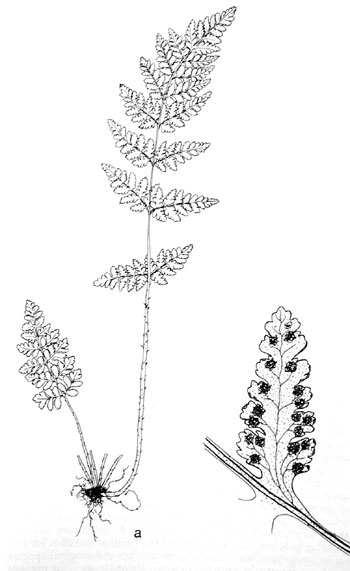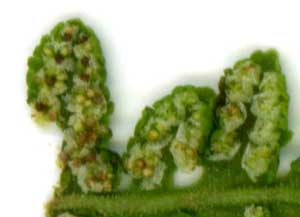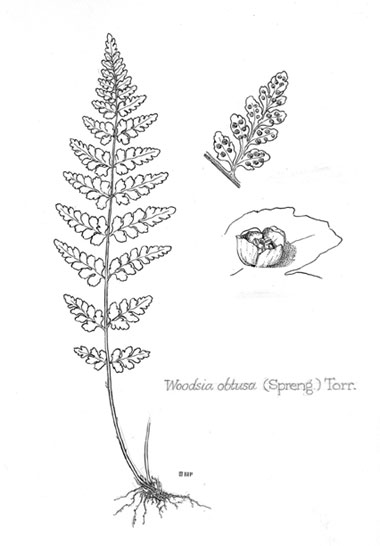|
Hardy Fern Home W. obtusa resources
All Ferns � Woodsiaceae �� Woodsia
�Other Genera
|
| Woodsia obtusa | ||
Blunt-lobed woodsia | ||
|
Etymology
Obtusa means blunt. The lobes of the indusium are blunt, as are the pinnules.
Description
Rhizome: creeping to erect, scales brown, uniform and others with a dark central stripe.
Frond: 40 cm high by 8 cm wide, evergreen sterile fronds, fertile fronds dying back, monomorphic superficially, but the sterile fronds decline and remain green through winter, blade/stipe ratio: 2:1. Stipe: persistent bases of unequal lengths, light brown or straw-colored when mature, occasionally darker at very base, scales tan, vascular bundles: 2, oblong, at an acute angle, at stipe base, merging above to a u-shape; the illustration below is not entirely in accord. Blade: 2-pinnate-pinnatifid at base, rhombic, tapering to both ends, truncated at base, herbaceous, gray-green, glands on both surfaces, rachis, costa with glandular hairs and scattered, often hairlike scales. Pinnae: 8 to 15 pair, lowest somewhat reduced, sessile or nearly so, pairs further apart the closer to the base; pinnules opposite, 3-8 pairs before degenerating into a pinnatifid pinna tip; costae grooved above, grooves continuous from rachis to costae; margins dentate or lobed; veins free, simple or forked, ending before the margin, vein tips usually enlarged to form whitish hydathodes visible above. Sori: round, in 1 row between midrib and margin, indusium: four lobes encircling sorus, persistent, translucent, basal, surrounding, sporangia: brown then black, maturity: early to midsummer. Dimensionality: pinnae held nearly horizontally. Culture
Habitat: rock ledges and slopes.
Distribution: eastern North America.
Hardy to -35�C, USDA Zone 3.
Distinctive Characteristics
In addition to the genus characteristics, cf.,note the lack of a jointed stipe (a jumble of old stipe bases of various lengths), in summer the diagnostic indusium (see Britton & Brown), in winter the evergreen sterile fronds
Synonyms
Polypodium obtusum Sprengel Aspidium obtusum Sw. Cystopteris obtusa Presl Woodsia perriniana (Sprengel) Hooker & Greville |
|
|

Woodsia obtusa. Habit, early June. �Ray Edwards, � 2004. |

Woodsia obtusa. a) fronds, unjointed; b) fertile pinna, glands, scales on the rachis and veins. �Illustration by V. Fulford from Ferns and Fern Allies of Canada, William J. Cody and Donald M. Britton, 1989, � Agriculture Canada, used with permission. |

Woodsia obtusa. Vascular bundle an inverted u-shape, the front of the stipe at the bottom of the image. �Drawing from Ferns of Northeastern United States, Farida A. Wiley, 1936. |

Woodsia obtusa sori early summer. �Scan, Tom Stuart |
